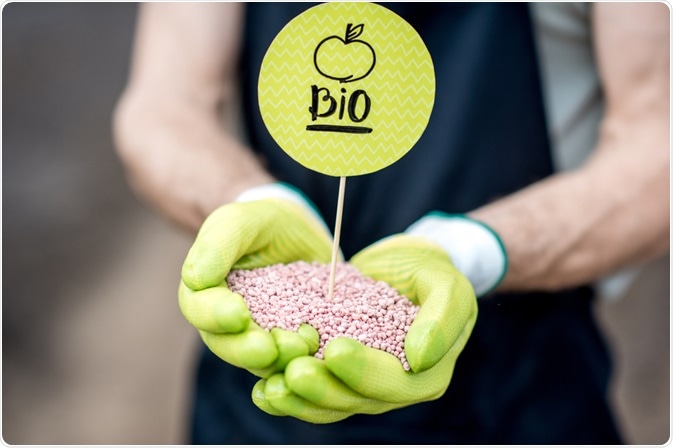We often think, how has the soil depleted so drastically and what impact does it have on our environment? A simple answer to that question would be, bad agricultural practice and rapid urbanization.

Image Credit: RossHelen/Shutterstock.com
Bio farming promotes the use of easily available natural resources and techniques such as green manure, crop rotation, biopesticides, biofertilizers, biological weed management, etc. This method of farming would ensure sustainable agriculture and would bring a positive change to our environment.
Over time, bio farming has gained many names such as biological agriculture, organic farming, green farming, eco-farming, etc. The use of natural products and technologies in agriculture could be an indirect approach through which we can come closer to achieving three crucial objectives i.e. a cleaner environment, a healthier lifestyle, and an affordable cost of living.
How do Agricultural Practices Affect the Environment?
Agriculture has a direct effect on our environment. Understanding the differences between organic and conventional farming can help us mitigate one of the persistent causes of environmental depletion. The major difference between the two farming practices is the impact on the land.
Conventional farming employs the usage of inorganic fertilizers and pesticides. This leads to the contamination of soil and food with agrochemicals, groundwater depletion, and a gradual decline in soil productivity by destroying key microorganisms that are present in the soil. Besides that, the cost of production is substantially higher under conventional farming.
The extensive usage of inorganic pesticides is detrimental to the invisible symbiotic microorganisms associated with plants. Endophytic microorganisms and microbes that are present in the rhizospheric soil play an important role in plant development and soil fertility. They enhance the crop yield by promoting the growth of roots/shoots and increasing plants’ biomass in various ways like phosphate solubilization, nitrogen fixation, establishing a heavy metal tolerance, and enhancing plants' resistance to pests, pathogens, biotic and abiotic stresses, etc. These microorganisms should and must be preserved.
Bio farming – A Sustainable Agricultural Practice
With the rapid change in the environment, the third world countries face the challenge of providing quality food for their people at a reasonable cost. Is bio farming an answer to this challenge? Bio farming is a holistic method that benefits both the environment and our society. This method of farming not only helps the vulnerable farmers economically by minimizing the cost of production but also restores the edaphic conditions and prevents the eco-system from the harmful effects of pesticides and chemical fertilizers.
Bio farming is a technique of cultivation that completely curtails the application of harmful chemicals leading to better quality food products with high nutritional values. This technique of farming establishes a connection within the agroecosystem that promotes both production and natural preservation.
The basic principles of bio farming are as follows:
- Conserving natural resources
- Maintaining a balanced ecosystem
- No use of chemical fertilizers and pesticides
- Use of biofertilizers and biopesticides
- Restoration of soil fertility and microbiome
- A healthy environment for sustainable agriculture
- Production of high-quality food in large quantities with minimal cost of input
- A safe working environment for farmers
Biofertilizers and Biopesticides
Biofertilizers are microorganisms (bacteria, fungi) that increase the nutrient availability to plants. They do so either by facilitating nutrient uptake or by enhancing the primary nutrient availability in the rhizosphere. This acts as a viable supplement to chemical fertilizers. The use of biofertilizers by the farmers has proved to be cost-effective and eco-friendly.
Additionally, it also promotes the remediation of polluted soil. Bioremediation of polluted soil is extremely essential since the soil is a non-renewable resource. Microbe based fertilizers are a vital part of sustainable agricultural practices. Microbes that are commercially used as biofertilizers are Rhizobium, Azobacter, Azospirillum inoculants, etc. They have the dual effect of enhancing the nutrient quotient of the soil and biodegradation of the heavy metal contaminants.
According to the Market Research Report, 2020, of Grand View Research, the global demand for biofertilizers was estimated to reach USD 2.70 billion by 2027.
Let us consider an example that proves the superiority of bio farming over conventional methods. The productivity of crops is greatly affected by the presence of heavy metals in the soil. Heavy metals are often present in the soil due to industrial effluents and metal-polluted water used for irrigation purposes.
One of the major soil contaminants is cadmium. Several researchers have investigated the effect of biofertilizers on cadmium contaminated soil. Their research has revealed that in the absence of biofertilizers, plant growth was negatively affected by cadmium stress, whereas, in the presence of biofertilizers cadmium tolerance not only increased but also better plant growth was recorded.
Additionally, an increased concentration of bioactive metabolites like proline and phenolic compounds were found when treated with biofertilizers. All of these advantages are foregone when conventional farming methods are employed.

Image Credit: Hryshchyshen Serhii/Shutterstock.com
Conclusion
This article shows how bio farming is a viable alternative to conventional farming that will help us preserve the environment, consume better quality food products, and in the process, enhance the quality of our lives significantly. Therefore, in the interest of the environment, bio farming should be actively promoted and employed.
References and Further Readings
- Iftikhar, S., et al. (2019). Synergistic mycoflora–natural farming mediated biofertilization and heavy metals decontamination of lithospheric compartment in a sustainable mode via Helianthus annuus. Int. J. Environ. Sci. Technol. 16, 6735–6752. https://doi.org/10.1007/s13762-018-02180-8
- Kumar, S., et al. (2017). Bio-Farming: A holistic approach for Social Upliftment and Better Health. South Asian J. Food Technol. Environ. 3(1), 521-525. DOI: 10.46370/sajfte.2017.v03i01.08
- Reddy G.C., et al. (2020). Biofertilizers Toward Sustainable Agricultural Development. In: Varma A., Tripathi S., Prasad R. (eds) Plant-Microbe Symbiosis. Springer, Cham. https://doi.org/10.1007/978-3-030-36248-5_7
Further Reading